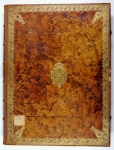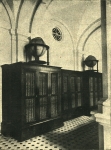The Print Room
of the Warsaw
University Library
56/66 Dobra Street
00-312 Warsaw
e-mail: gabryc.buw@uw.edu.pl
tel.: (22) 55 25 830
OPENING HOURS
Tuesday and Thursday
10.00 – 18.00
Print Room established in 1818 has been the oldest and – by 1939 – the largest public collection of prints and drawings in Poland. Despite extensive losses suffered during World War II (approx. 60% of the whole collection) it has retained an outstanding position in the history of Polish collecting and collections due to the artistic and historic value of its holdings. At present the collection includes approximately 50,000 master and architectural drawings, single leaf prints and bound volumes of prints spanning the 16th to 20th century. Nearly all West European schools of graphic arts are present and the majority of works reflect 17th and 18th century artistic output in the field. The Print Room acquires, houses, preserves and provides access to the collections of prints and drawings and their curators are involved in various scholarly, exhibition and educational projects and activities.
The core of the Room holdings consists of King Stanisław August Poniatowski’s Print Room purchased for Warsaw University from the King’s successors in 1818. The collection includes (mostly 17th and 18th century) prints and drawings the majority of which are ordered according to their subjects and placed in characteristic boxes covered with leather, so‑called royal portfolios. In the period between 1818 and 1821 StanisławKostkaPotocki, who proposed the purchase of the afore-mentioned collection, donated to Warsaw University a considerable part of his own collection of prints and drawings, including works of 16th and 17th century European Masters. All objects in question were transferred to Warsaw University Library opened in 1816 and the traditional name of the royal collection – the Print Room – was assigned to the collection of all graphic works owned by the University. After the collapse of the November Uprising the Print Room collections were transferred to Petersburg, Russia (1832), incorporated in the holdings of Petersburg Academy of Fine Arts and expanded with the collections owned earlier by the Friends of Science Society in Warsaw and Duke EustachySapieha from Dereczyn. In 1923 the resolutions of the Treaty of Riga resulted in the restitution of the collections in question by the Library. In the period between 1924 and 1939 the collections were enhanced with objects purchased, received as donations and acquired by the Library after 1832 such as the archives of Tylman van Gameren, Dominik Witke-Jeżewski’s collection, doctor IzydorKrzemicki’s collection (16th to 18th century chiaroscuro woodcuts) and HenrykGrohman’s collection (West European and Polish prints from the turn of the 19th and 20th century).World War II was a tragic period in the history of the Print Room which suffered the loss of nearly 60% of the collection consisting of more than 100,000 items, including the reference library, photograph archives, inventories and catalogs. The Nazi occupying forces pillaged the most valuable objects and a large part of the collection was torched in the building of Krasiński Library after the collapse of Warsaw Uprising in 1944. The decisive attempts at reclaiming looted and lost properties immediately after the end of World War II enabled the Library to regain its severely decimated holdings and the Print Room was reopened as early as January 1946. In 1955 it was transferred to Tyszkiewicz-Potocki Palace in KrakowskiePrzedmieście Street 32 and in the academic year 2001/2002 it became accessible in a new building of Warsaw University Library in Dobra Street 56/66.








